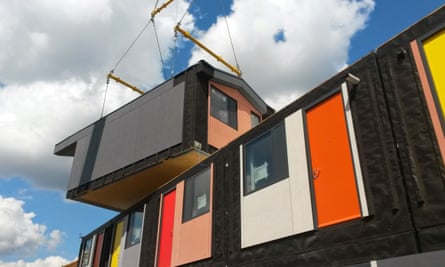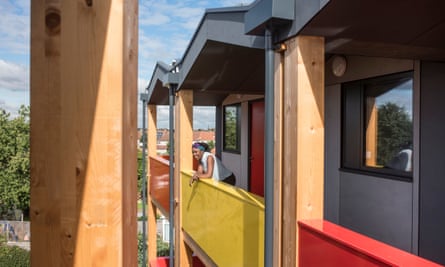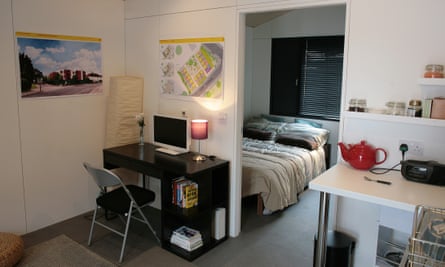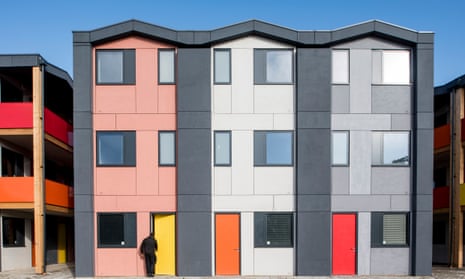“I still can’t quite believe that the same architects who designed Terminal 5 and the Cheesegrater have designed my house,” says Wendy Omollo. “To have people as grand as that doing low-cost housing projects is really quite amazing.”
Omollo has been homeless since January, but this week she will join 35 others when she moves into the YMCA’s first factory-built “move-on” housing scheme, designed by none other than multi-award winning, international airport designing Rogers Stirk Harbour + Partners. While Richard Rogers’ practice graces this year’s Stirling prize shortlist for the sixth time, with the controversial Neo Bankside development and its £22m penthouses, it might come as a surprise to learn that a little further south, in the London borough of Merton, his office has just completed this scheme for a cost of around £45,000 per apartment, to be rented at less than the council’s affordable housing allowance.
Developed over the last few years in partnership with the YMCA London South West, manufacturers SIG and project managers Aecom, this 36-unit “Y:Cube” project is the practice’s latest foray into off-site manufactured housing, a dream Richard Rogers has entertained since his “Zip-Up” concept house in the 1960s – an unrealised fantasy of a modular pink prefab pod on stilts.

A more prosaic version of that dream came partially true in 2007 with the practice’s first experiment in factory-built housing at Oxley Woods in Milton Keynes. The scheme was showered with plaudits at the time, but has been plagued by leaks and legal claims ever since. In the charitable hands of the YMCA, might the concept fare any better?
On paper, the benefits are clear and indisputable. Each apartment is built under controlled conditions in a factory in Derbyshire, increasing precision and quality control while minimising waste, then craned into place on site, with services already installed. This process takes about half the time of conventional construction and it’s a good deal cheaper, at around £1,400 per sq m (as opposed to the usual £2,000 for local authority new-builds). Each studio apartment comes with its own en-suite bedroom and living room with a galley kitchen and, crucially, each unit has its own front door, giving the residents a sense of their own place, often for the first time. And, even though it’s made in a factory, there’s nothing particularly futuristic about any of it.

“It’s all simple technology,” says RSH+P architect Andrew Partridge, describing the structure as a basic timber frame with MDF or plasterboard lining and simple cement board rain-screen cladding. The level of insulation and airtightness means bills for heating and electricity should be as low as £10 per month, while the cost-saving in construction means the units can be rented for £150 per week, 65% of the local market rate. The units have a lifespan of around 60 years, during which they can be moved and re-installed up to five times.
“Factory construction is just common sense,” says YMCA’s Simon Tanner, who was a corporate finance director at PricewaterhouseCoopers until this year, now tasked with scaling the Y:Cube model and attracting social investors. “You wouldn’t buy a car that was built in a field, so why buy a house that’s been built that way?”
It is the mantra recited by every factory-housing evangelist, and they’ve got a point. The building industry can seem positively medieval compared to other manufacturing sectors, still insisting on summoning structures on site from a churning sea of clay and mud, under the kind of chaotic conditions in which you wouldn’t want to assemble an Ikea wardrobe, let alone a whole house.
But visiting the Y:Cube scheme, which stands at the end of a row of traditional pebble-dashed semis on Woodstock Way, it’s easier to understand why factory-built housing hasn’t taken off yet. The project is a fine achievement, given the constraints of cost and time (the whole thing was built in five months), but it can’t help but exude the characteristics of the family of portable classrooms and temporary business-park sheds from which it comes.

The colour choice is odd for housing: large swathes of dark corporate grey cement board face the street, punctuated by bands of peach and beige, while the inner courtyard-facing walls are peppered with a Starburst riot of red, yellow and orange, the garish gloss-painted panels giving it a certain easyJet quality. It all feels slightly patronising for move-on housing, dressed in the child-like garb of a My First House, while some elements are downright shoddy, like the clumsy metal staircase leading to the access decks. But such niggles are clearly minor to the tenants facing the prospect of having their own home for the first time. “I love it!” says Omollo. “The vibrant colours really suit my character.”
While half of the tenants come from YMCA hostels, the other half are from Merton’s housing waiting list, and many other local authorities have taken a keen interest. The YMCA is looking at a number of other sites for the Y:Cube model to be rolled out, Tanner suggesting there could be “thousands” in the pipeline.
“The beauty of the system for a council is that they can put these on a vacant site for five years, then move them on when that site is ready for development,” he says, adding that they are currently in talks with Transport for London about using TfL sites. The project has the keen backing of the Mayor of London, whose deputy for housing and land, Richard Blakeway, hopes the project “is the first of many more to come across London.”
The initiative clearly has momentum to be scaled up, and yet the Y:Cube units don’t actually meet the mayor’s own housing design guidelines. Each unit provides just 26 sq m of internal area, as opposed to the recommended 37 sq m for a one-person studio flat specified in the London Housing Design Guide.

“The development of volume factory-built housing is a welcome step, and it’s encouraging that it has received such high-level backing,” says architect Alex Ely, who worked on the design guide. “But there’s a danger that this becomes an excuse for local authorities not to deliver long-term solutions for affordable housing, and merely use these types of buildings as a stop-gap – like the post-war prefabs, when there was a desperate need to build quickly. We should be careful that we’re really spending time getting it right.”
RSH+P thinks it has the winning formula already. The architects are currently working on plans for a similar development in Lewisham, the £4.3m Ladywell “pop-up village” of 24 two-bed homes, which looks even more like an out-of-town data centre, a vast grey shed this time adorned with pink, yellow and green panels. The homes will be in place for no more than four years, while the council decides on a long-term plan for the site, after which the structure will be moved elsewhere in the borough.
Y:Cube is a laudable initiative to ease the country’s urgent housing need for those in desperate circumstances – but it must guard against being rolled out as an alternative to councils providing long-term affordable homes. If taken up as the silver bullet to endless waiting lists, there’s a very real risk it could sow the seeds for a future of cheaply built, meanly scaled, less stable housing that can be conveniently swept away at a moment’s notice.

Comments (…)
Sign in or create your Guardian account to join the discussion